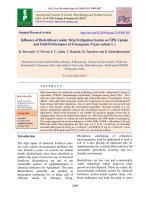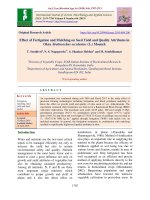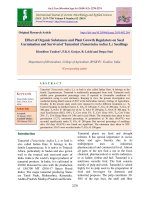Effect of gamma irradiation on seed germination and seedling vigour of mungbean [Vigna radiata (L.)]
Bạn đang xem bản rút gọn của tài liệu. Xem và tải ngay bản đầy đủ của tài liệu tại đây (68.48 KB, 6 trang )
Int.J.Curr.Microbiol.App.Sci (2019) 8(10): 598-603
International Journal of Current Microbiology and Applied Sciences
ISSN: 2319-7706 Volume 8 Number 10 (2019)
Journal homepage:
Original Research Article
/>
Effect of Gamma Irradiation on Seed Germination and Seedling
Vigour of Mungbean [Vigna radiata (L.)]
D. L. Sundesha1*, M. P. Patel2, A. M. Patel3 and S. K. Parmar4
1
College of Horticulture, S.D. Agricultural University, Sardarkrushinagar-385 506, India
Department of Genetics and Plant Breeding, C. P. College of Agriculture, S. D. Agricultural
University, Sardarkrushinagar-385 506, India
3
Seed-Spices Research Station, S. D. Agricultural University, Jagudan-382 710, India
4
Pearl Millet Research station, Junagadh Agricultural University, Jamnagar- 361 006, India
2
*Corresponding author
ABSTRACT
Keywords
Mungbean, Gamma
rays, LD50,
Seedling vigour
Article Info
Accepted:
07 September 2019
Available Online:
10 October 2019
The pure, healthy and dry seeds of four mungbean varieties i.e., Meha, K
851, GM 3 and GM 4 were irradiated with different doses of gamma rays
(400, 500 and 600 Gy) for study the effect on seed germination and
seedling vigour such as germination per cent, shoot length (cm), root length
(cm), fresh weight (g) and dry weight (g). For LD50 recorded near to the
600 Gy gamma rays as per survival per cent in the all four mungbean
varieties. The GM 4 was observed more sensitive, whereas, Meha was
recorded more resistance for most of all traits. The present results clearly
indicated that different doses of gamma rays can be effectively utilized to
create variability for different quantitative characters in all the four
varieties.
Introduction
Mungbean [Vigna radiata (L.) Wilczek] is the
most important pulse crop in India. In the
traditional vegetarian diet of Indian
population, pulses occupy second place next
to cereal and is the main source of protein,
ranking after chickpea and pigeonpea.
Mungbean, an important seed legume, is a
short duration crop and plays vital role in
meeting the quantitative and qualitative
requirement of food and protein throughout
the world. Mungbean provide 24 per cent
protein and the seeds are considered to be
easily digestible (Chauhan and William,
2018). It also provides nutritional fodder to the
cattle and improves the soil fertility through
atmospheric nitrogen fixation with the help of
Rhizobium species. Plant breeders always look
for large and diverse gene pool of variability
as it is a prerequisite for success in any
breeding programme. In mungbean, natural
598
Int.J.Curr.Microbiol.App.Sci (2019) 8(10): 598-603
variability is limited and hybridization is little
difficult due to cleistogamous and small
flower structure. Therefore, induced mutation
technique was followed to create genetic
variability by artificial means.
Materials and Methods
The true pure seeds of four mungbean varieties
viz., Meha, K 851, GM 3 and GM 4 were procured
from the Pulse Research Station, SDAU,
Sardarkrushinagar. Pure, healthy and mature seeds
of the selected varieties were exposed to different
doses of gamma rays (400 Gy, 500 Gy and 600
Gy) with an intensity of 18 Gy per minute at
Bhabha Atomic Research Centre (BARC),
Trombay. Seeds not irradiated to gamma ray
which were concern as a control. In each
treatment, In laboratory condition, 25 seeds were
sown treatment wise in the cement pipe structure
with proper plant as well as row spacing during
summer-2014. Germination of seeds were
carefully examined everyday and the emergence of
cotyledonary leaf was taken as the induction of
germination, germinated seeds of each treatment
were counted on eighth day after sowing and
germination percentage was calculated. Fifteen
days of after sowing, shoot and length were
measured in centimeter and fresh weight (g) was
recorded, seedlings were put in oven at constant
50ºC temperature for 48 hours and after these
seedling weight was recorded as dry weight (g)
and total number of seedlings survived were
counted after fifteen day of sowing and plant
survival percentage were calculated in the M1
generation.
Results and Discussion
In present study, the highest mean germination
per cent (88, 96, 96 and 92) and survival per
cent (88, 96, 96 and 92) was observed in
control treatment, whereas lowest mean
germination per cent (56, 68, 68 and 60) and
survival per cent (48, 48, 60 and 40) was
recorded at 600 Gy in four varieties Meha, K
851, GM 3 and GM 4, respectively (Table 1).
Mean germination per cent was reduced in all
four varieties with the increase in gamma rays
doses. The perusal of the results suggested that
the dose of gamma rays was increased when,
the germination per cent and survival per cent
were
reduced.
Differential
genotypic
sensitivity to different mutagen doses within a
species have also been reported by several
workers viz., Balai and Krishna, 2009; Kumar
et al., 2010; Sagade and Apparao, 2011, Singh
and Singh, 2013 and Hemavathy, 2015 in
Vigna radiata. Cherry and Hageman (1961)
opined that impairment of mitosis or, virtual
elimination of cell division in the meristematic
zone during germination in irradiated seeds
with higher doses led to seed lethality.
However, Selim et al., (1974) reported that
reduction in germination due to higher
exposure to radiation was due to production of
active radicals. Sato and Gaul (1967) reported
that seedling injury led to slow growth
culminating in early mortality. Chromosomal
aberrations as impacted by irradiation caused
reduction in fertility and enhancement of
physiological disorders causing seedling
injury, slow growth and ultimately early
mortality (Mehetre et al., 1994; Avinash and
Tewari, 1998). Higher degree of damage
incited by irradiations to chromosomal
materials also results in inhibition of growth
hormones. All these factors cumulatively may
be attributed as the reason for reduction of
plant survival.
Highest shoot length (6.90, 6.71, 7.06 and
7.05 cm), root length (7.40, 7.35, 7.54 and
7.41 cm), fresh weight (1.05, 1.09, 1.15 and
1.13 g), dry weight (0.52, 0.55, 0.62 and 0.59
g) were recorded under control treatment in
Meha, K 851, GM 3 and GM 4, respectively.
Mean shoot and root length as well as mean of
fresh and dry weight were declined in all four
varieties with increase in gamma rays dose.
599
Int.J.Curr.Microbiol.App.Sci (2019) 8(10): 598-603
Table.1 Effect of different doses of gamma rays on seed germination and seed survival per cent in mungbean cultivars under
laboratory conditions
Varieties
Treatments
Gamma
Number
of seeds
sown
Meha
Control
400 Gy
500 Gy
600 Gy
Control
400 Gy
500 Gy
600 Gy
Control
400 Gy
500 Gy
600 Gy
Control
400 Gy
500 Gy
600 Gy
25
25
25
25
25
25
25
25
25
25
25
25
25
25
25
25
K 851
GM 3
GM 4
Seed germination
Number of
Mean
Reduction
seeds
germination
over
germinated
in per cent
control
per cent
22
88
20
80
09.00
17
68
22.73
14
56
36.36
24
96
22
88
08.33
18
72
25.00
17
68
29.17
24
96
23
92
04.17
19
76
20.83
17
68
29.17
23
92
22
88
04.35
20
80
13.04
15
60
34.78
600
Per cent seed survival
Number of
Mean
Reduction
seeds
survival in
over
survival
per cent
control
per cent
22
88
17
68
22.73
16
64
27.27
12
48
45.45
24
96
21
84
12.50
18
72
25.00
12
48
50.00
24
96
20
80
16.67
18
72
25.00
15
60
37.50
23
92
21
84
08.70
20
80
13.04
10
40
56.52
Int.J.Curr.Microbiol.App.Sci (2019) 8(10): 598-603
Table.2 Per cent reduction in shoot length (cm) and Root length (cm) and Fresh and Dry weight (g) in mungbean cultivars
under different treatments in laboratory conditions
Varieties Treatments
Meha
K 851
GM 3
GM 4
Control
400 Gy
500 Gy
600 Gy
Control
400 Gy
500 Gy
600 Gy
Control
400 Gy
500 Gy
600 Gy
Control
400 Gy
500 Gy
600 Gy
Shoot length (cm)
Mean
Per cent
(cm)
reduction
over
control
6.90
4.15
39.86
3.83
44.49
3.35
51.45
6.71
4.12
38.64
3.75
44.14
3.24
51.71
7.06
4.30
39.14
3.91
44.67
3.37
52.31
7.05
4.19
40.54
3.86
45.20
3.38
52.05
Root length (cm)
Mean
Per cent
(cm)
reduction
over
control
7.40
4.90
33.78
4.50
39.19
3.68
50.27
7.35
4.85
34.04
4.40
40.13
3.54
51.81
7.54
5.02
33.42
4.52
40.12
3.73
50.58
7.41
5.02
32.22
4.58
38.24
3.86
47.89
601
Fresh weight (g)
Mean
Per cent
(g)
reduction
over
control
1.05
1.03
02.05
0.99
06.14
0.97
07.77
1.09
1.04
04.76
1.00
08.55
0.97
10.69
1.15
1.09
05.22
1.05
08.70
1.03
10.43
1.13
1.06
06.39
1.02
10.12
1.00
11.78
Dry weight (g)
Mean
Per cent
(g)
reduction
over
control
0.52
0.49
05.78
0.51
01.36
0.46
11.47
0.55
0.50
09.89
0.52
05.23
0.46
15.56
0.62
0.55
11.21
0.57
07.56
0.52
15.83
0.59
0.52
12.06
0.54
08.73
0.49
17.15
Int.J.Curr.Microbiol.App.Sci (2019) 8(10): 598-603
These traits mean values were recorded
highest in control, whereas, lowest mean
values were recorded at 600 Gy (Table 2). The
results suggested that differential response to
different doses of gamma rays. The reduction
in shoot length and root length were thus more
pronounced in higher doses as compared to
the lower doses of gamma rays and their
respective to untreated control. The varietal
response of mutagen was little founded. The
reduction in shoot and root length recorded in
the flat studies has been attributed to changes
in the levels of auxin and ascorbic acid and to
physiological and bio-chemical disturbances
(Gunkel and Sparrow, 1954 and Singh, 1974)
or chromosomal aberrations changes in
enzymatic activity and impaired mitosis in the
meristematic zone of growing seedlings
(Cherry and Hageman, 1961). It might be due
to decrease in respiratory quotient in the
seedlings obtained from treated seeds. Such
chromosomal aberrations caused due to
induction of mutation have also been reported
by Nandanwar and Patil (2000).
In this study, GM 4 was observed more
sensitive, whereas, Meha was recorded more
resistance for most of all traits. The results
clearly indicated that different doses of
gamma rays can be effectively utilized to
create variability for different quantitative
characters in all the four varieties.
References
Avinash, C. and Tewari, S.N. (1998). Effect of
fast neutrons and gamma radiation on
germination, pollen and ovule sterility
and leaf variations in mungbean. Acta
Botanica Indica. 6: 206-208.
Balai, O.P. and Krishna, K.R. (2009).
Efficiency and effectiveness of
chemical mutagens in mungbean.
Journal of Food Legumes. 22(2): 105108.
Chauhan, Y.S. and Williams, R. (2018).
Physiological
and
Agronomic
Strategies to Increase Mungbean Yield
in Climatically Variable Environments
of Northern Australia. Agronomy. 8
(6): 1-20.
Cherry, J.H. and Hageman, R.H. (1961).
Nucleotide and ribonucleic acid
metabolism of corn seedlings. Plant
Physiology. 36: 163-168.
Gunkel, J.E. and Sparrow, A.H.(1954).
Aberrant growth in plants induced by
ionizing
radiation.
Brookhaven
Symposium Biology. 6: 252-279.
Hemavathy, A.T. (2015). Effect of gamma
irradiation on seed germination and
seedling growth of Vigna radiata (L.)
Hepper. International Journal of
Advanced Scientific and Technical
Research. 2 (5): 155-158.
Kumar, A., Parmhansh, P., Mandal, R.K. and
Prasad, R. (2010). Induced mutations
in mungbean (Vigna radiata L.
Wilczek). Agriculturist. 54 (3/4): 173178.
Mehetre, S.S., Mahajan, C.R. and Dhumal,
P.M. (1994). Effects of different doses
of gamma irradiation on germinations
and survival of soybean. Soybean
Genetics News Letter. 21: 101-112.
Nandanwar, R.S. and Patil, A.N. (2000).
Meiotic chromosomal aberrations,
spectrum and frequency of chlorophyll
and macro mutations induced by
gamma rays, EMS and hydroxylamine
in [Vigna radiata (L.) Wilczek]. DAEBRNS Symposium, Mumbai.: 156165.
Sagade, A.B. and Apparao, B.J. (2011). M1
Generation Studies in Urdbean [Vigna
mungo (L.) Hepper]. Asian Journal of
Experimental Biological Science. 2
(2): 372-375.
Sato, M. and Gaul, H. (1967). Effect of EMS
on the fertility of barley. Radiation
Botany. 7: 7-15.
Selim, A.R., Hussein, H.A.S. and El-Shawaf,
602
Int.J.Curr.Microbiol.App.Sci (2019) 8(10): 598-603
L.L.S. (1974). Journal of Genetical
Cytology. 192. Fide: Perspectives in
Cytology and Genetics. (Ed. Manna,
G.K. and Sinha, U.). Hindasa
Publication, New Delhi.: 353-356.
Singh, B.B. (1974). Radiation induced
changes in catalase, lipase and ascorbic
acid of safflower seeds during
germination. Radiation Botany. 14:
195-199.
Singh, K. and Singh, M.N. (2013).
Effectiveness and efficiency of
Gamma rays and Ethyl Methane
Sulphonate (EMS) in mungbean.
Journal of Food Legumes. 26 (3 and
4): 25-28.
How to cite this article:
Sundesha, D.L., M.P. Patel, A.M. Patel and Parmar, S.K. 2019. Effect of Gamma Irradiation on
Seed Germination and Seedling Vigour of Mungbean [Vigna radiata (L.)].
Int.J.Curr.Microbiol.App.Sci. 8(10): 598-603. doi: />
603
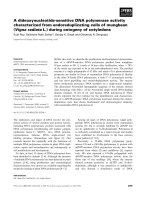

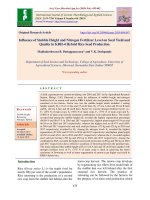

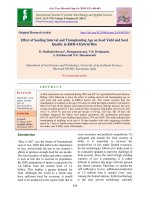
![Effect of fertility levels and stress mitigating chemicals on nutrient uptake, yield and quality of mungbean [Vigna radiata (L.) Wilczek] under loamy sand soil of Rajasthan](https://media.store123doc.com/images/document/2020_01/09/medium_ftp1578562755.jpg)
